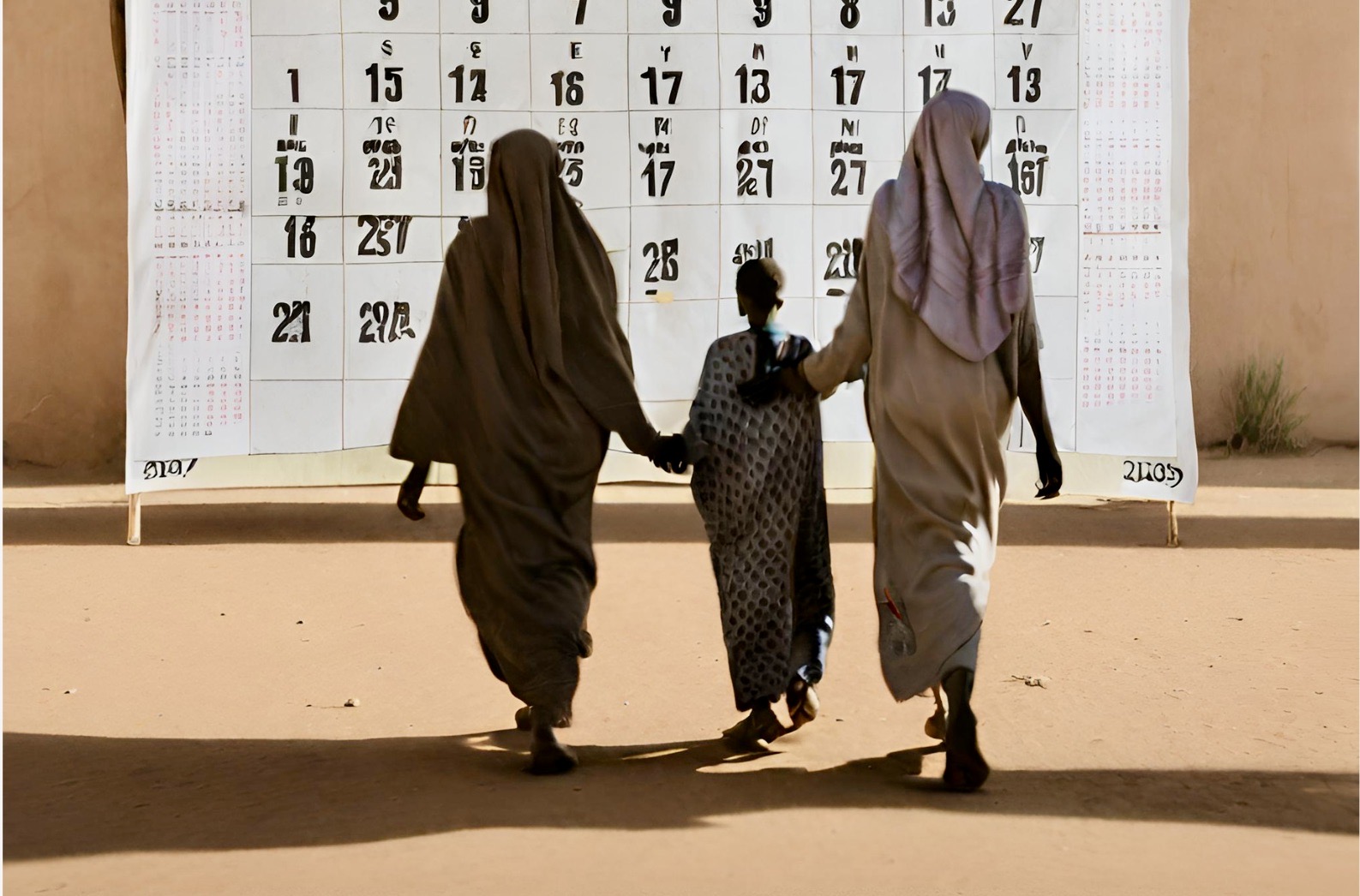Sudan Conflict Monitor #12
19 April 2024
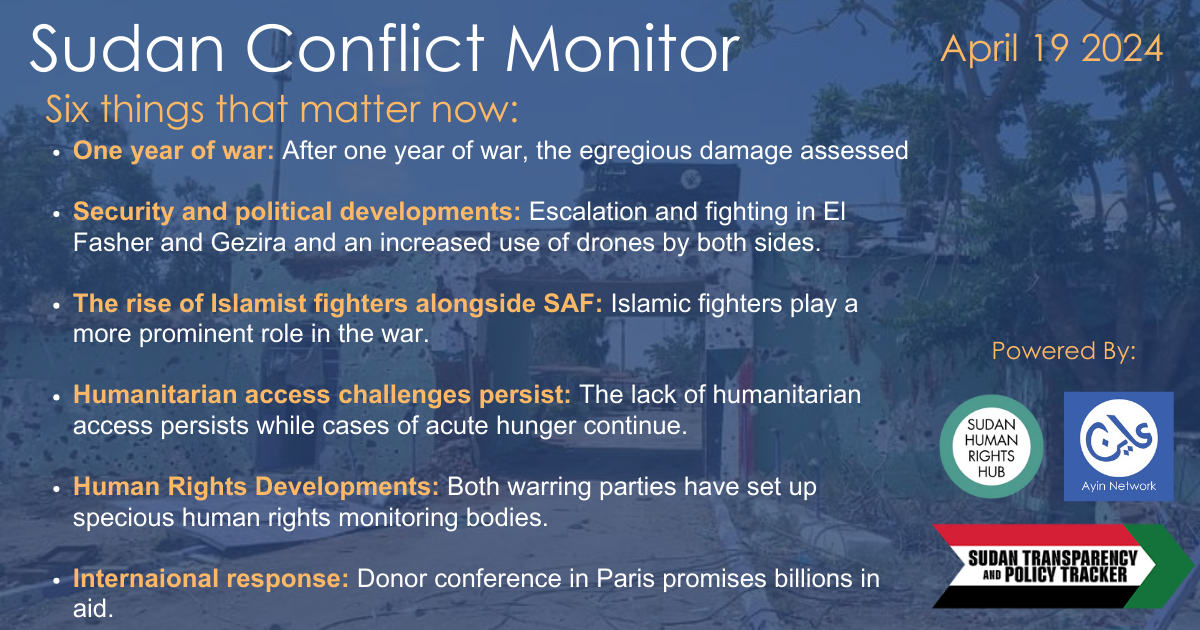 The Sudan Conflict Monitor is a rapid response to the expanding war in Sudan written through a peace-building, human rights, and justice lens. Here we have tried to capture the five most important stories in Sudan. Please share it widely.
The Sudan Conflict Monitor is a rapid response to the expanding war in Sudan written through a peace-building, human rights, and justice lens. Here we have tried to capture the five most important stories in Sudan. Please share it widely.
Powered by Ayin Media and the Sudan Transparency and Policy Tracker
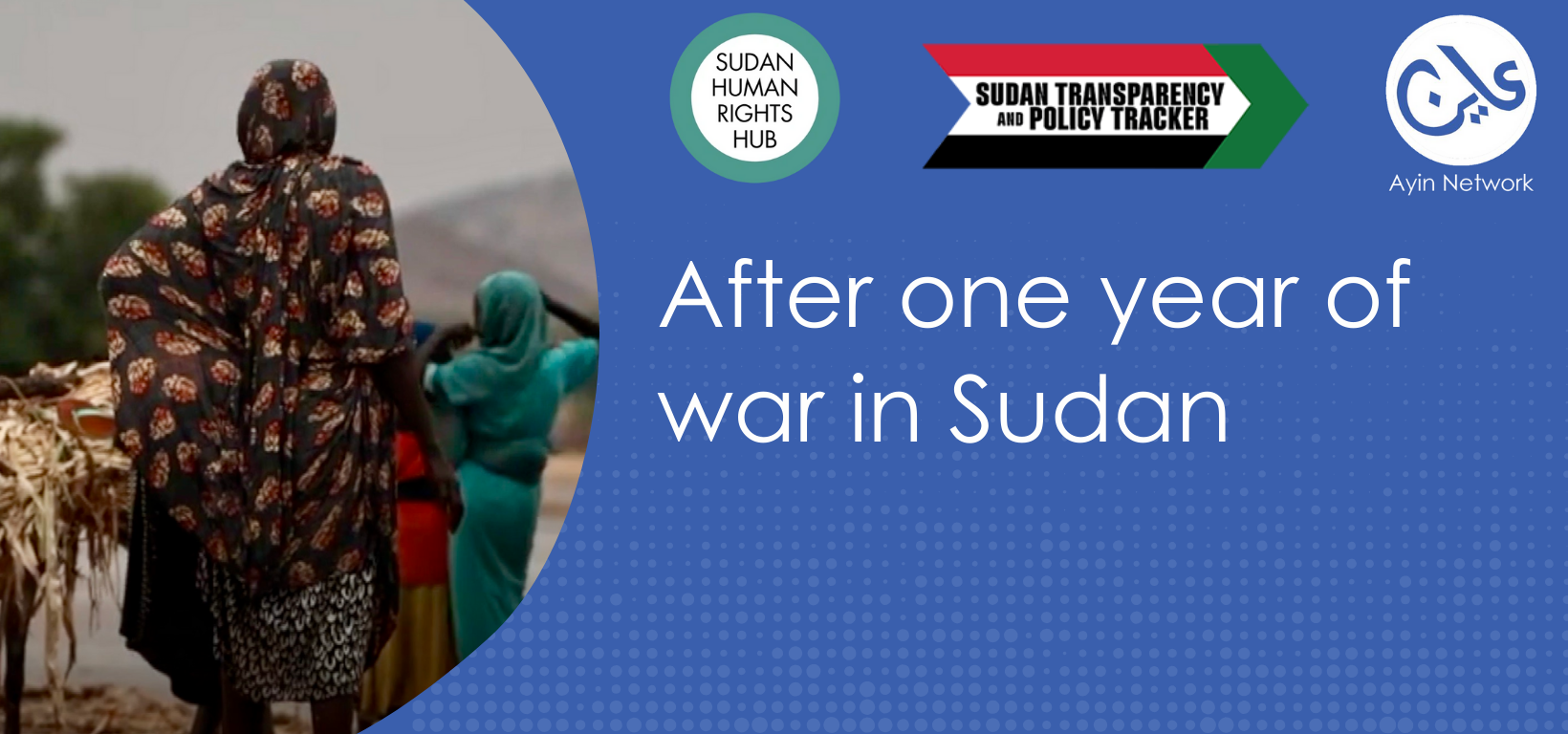
1. After one year of war in Sudan
As it enters its second year, the war in Sudan is rapidly growing more complex and drawing in a larger proportion of the population as both the Rapid Support Forces (RSF) and the Sudan Armed Forces (SAF) resort to mobilising civilian populations—often along ethnic lines—to replenish their ranks.
Both sides are also now using weaponized drones. The SAF made significant gains in Omdurman following its acquisition of Iranian Shahid 4 and 6 and Ababil drones. There are indications that the RSF may have recently acquired Chinese Sunflower-200 drones. While the RSF denied responsibility for the drone attack on the SAF-controlled northern town of Atbara on April 2 and in Gedaref on April 9, the two incidents underscored that no part of Sudan is safe from this war.
Continuing to build on the offensive posture that it recently adopted in Khartoum State in February, in April, the SAF launched a multipronged offensive to reclaim Gezira State from the RSF. SAF is also mobilising in Kosti to free the national highway to the besieged capital of North Kordofan, El-Obeid. The RSF amassed troop reinforcements to repel the attacks.
There have been at least 140 major battles and 120 cases of violence against civilians since the conflict began, causing widespread casualties. ACLED has documented nearly 15,000 deaths across the country, but this is likely an undercount due to difficulties in monitoring casualties. The UN panel of experts estimated that 10–15,000 people were killed in West Darfur alone. Local doctors believe the total number of conflict-related deaths is much higher than has been reported. In addition, a high number of Sudanese patients are dying from a lack of access to health facilities, according to the Sudanese Doctors’ Union.
The warring sides have attacked health facilities across the country. From the outbreak of conflict until February 2024, there were 267 recorded attacks on the medical sector in Sudan, including the destruction of 58 medical facilities. Roughly 80% of hospitals in Sudan are inoperable. A recent Ayin and Sudan Human Rights Hub report highlights these attacks.
The conflict has also triggered mass displacement—the highest level of conflict displacement in the world—with IOM reporting over 10 million people forced to relocate either inside or outside of the country. Over 300,000 civilians were displaced in December – January 2024 from Gezira State alone. A recent documentary by Fresh Eyes News highlights some personal stories of these displaced people to show the human side of these numbers.
Forced displacement also undermined agricultural production, particularly in Gezira State, once considered a breadbasket for the country. This has contributed to extreme levels of food insecurity. Areas of cultivation declined by roughly 60% this year. An estimated 18 million Sudanese are facing a hunger gap. Of these 18 million, 5 million may face starvation in the months ahead. Sudan’s economy shrank by 40% in 2023, while inflation has skyrocketed to 256%—an increase of 117 percent. Exports and trade have declined by about 60% due to the closure of the airport and the suspension of most dry ports.
In the first eight months of the war, 118 cases of sexual assault were documented. Activists believe the actual figure is much higher due to the stigma associated with reporting and difficulties in monitoring. Roughly 3.7 million children, especially those living in shelters and displaced from war, currently suffer from malnutrition. 19 million children are out of school, while the army insists on students participating in the national exams.
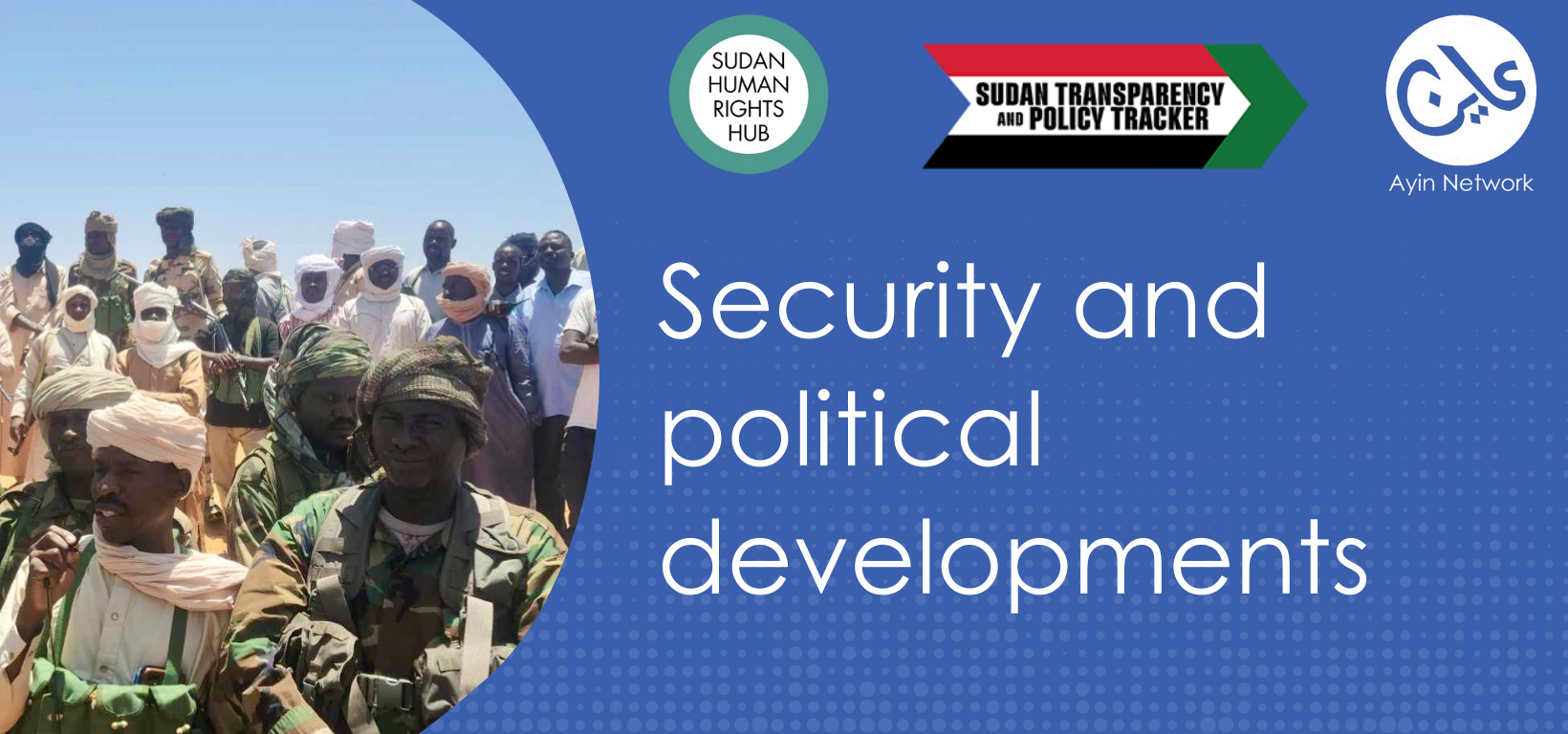
2. Security and Political Developments
Recent weeks have seen an uptick in fighting as the warring sides each sought victories during the April 10–12 Eid holiday and in anticipation of potential upcoming ceasefire talks. Although frontlines in central Sudan have remained relatively static, the fighting has intensified and expanded geographically, igniting clashes across a number of new fronts and sparking fears that Sudan is entering a “new phase” of conflict.
Khartoum
Sources in and close to the SAF say the army’s leadership is quite pleased with progress in the Khartoum-Omdurman-Bahri tri-city area, which remains its top military objective. In early March, SAF connected its positions in eastern Omdurman, securing routes from the Wadi Saeedna and Karari areas to its base in Mohandiseen, as well as re-capturing the National Television and Radio Station. SAF has continued to move southward towards the Fitihab bridge and eastward towards Souk Libya, a central hub of food supplies for RSF soldiers.
In Bahri, SAF has advanced from eastern positions in Kadaro and Hattab to exercise greater control of roads south of the RSF-held Al-Jaili refinery, destroying several RSF petrol re-supply convoys. Although SAF still faces significant challenges in its enclaves around the Kober Signal Corps, General Command Headquarters, and remnants of the Shajara Armoured Corps, its units appear heartened to have received support in the past months via foreign and domestic made drones, new shipments of munitions, and reinforcements from popular mobilisation (mustanfareen), Popular Resistance battalions, and SAF-aligned Darfuri armed groups that had previously gathered in northern Sudan.
Gezira
SAF’s has also launched an offensive aimed at retaking Wad Medani which is proceeding along three axes:
1.) From the west, the 18th division and mustanfareen units moved from Kosti-Rabak towards Manaqil, Gezira State, but not further for fear of an RSF counterattack against either White Nile State or Manaqil itself.
2.) From the south, remnants of the 1st Division from Wad Medani have joined the 17th Division from Sinja and mixed 4th Division / SPLM-N-Agar forces from Damazin in the city of Sennar, but face challenges from RSF mobile forces manoeuvring around the city in at least three directions.
3.) The 2nd Division, alongside pro-SAF elements of SLA-Minni Minawi, Justice and Equality Movement (JEM), SLA-Mustafa Tambour, and other militia groups, have made initial progress from Al-Fao towards Medani but face coordination challenges and RSF ambushes along the way.
The RSF continues to contest key frontline areas in central Sudan but has begun to face military consequences for its often-cited command and control problems and internal discord. According to several insiders with knowledge of the RSF, mobilizers set a recruitment target of 25,000–30,000 new recruits between January and February 2024. To meet this target, they employed strategies like forced recruitment and a growing reliance on lawless auxiliary militias, sometimes referred to as kasaba or shifshifa (those engaged in looting warfare), to bolster their numbers.
The RSF appears to be seeking to counter the impression that they are unable to govern by setting up new governance structures. For instance, according to Alsharq Alawsat, they have now established a civil administration in Gezira State. The 31-member administration seeks to address the disorder that has gripped the state since the RSF’s takeover in December. It is also a sign of the unique challenges that the RSF is facing in Gezira—it has not set up parallel structures in the other states that it controls in Darfur.
In western Omdurman, RSF High Command was already plagued by leadership infighting after the deaths of several highly respected commanders, such as Musa Abouda in the Karari-Mohandiseen corridor, and has struggled to bring discipline to auxiliaries, many of whom have coalesced in the Souk Algash area. In Gezira, where RSF forces rampaged across villages state-wide and committed serious crimes against civilians, the high command devoted significant effort to curtailing discipline issues before ultimately consolidating forces inside Wad Medani in anticipation of SAF advances. Although RSF’s supply lines across western Sudan remain robust, it faces local supply shortages such as food in western Omdurman, petrol in Bahri and Khartoum, and cash and medicine in the hinterlands of South and Central Darfur.
El Fasher
The April 13th commencement of fighting between RSF and a pro-SAF coalition of Juba Peace Agreement (JPA) signatory armed groups hailing from SLA-MM, JEM, and factions of the Gathering of Sudan Liberation Forces (GSLF) to the west of El Fasher is believed to be the culmination of months of tensions between armed actors from both sides. RSF leadership has emphasised their grievance as solely political, objecting to the pro-SAF position of JPA leaders such as Minni Minawi, Jibril Ibrahim, and Mustafa Tambour. However, there are indications the fighting will take on broader ethnic dimensions, drawing in Abbala Riziegat and other RSF-aligned groups and factions of ethnic Zaghawa supporting the JPA groups. The previous months had seen fighting between Zaghawa and RSF-aligned groups over the shared war economy of North Darfur, such as over checkpoints and smuggling routes and diversion of humanitarian convoys. In addition, leaders and influencers on both sides have increased inflammatory rhetoric. Some speculate that RSF’s strategy in fighting pro-SAF Darfur armed movements is to prevent them from sending reinforcements to the capital and Gezira state.
The fighting began when Zaghawa militia rustled 250 heads of cattle in early April, according to sources close to the Darfur movements that are associated with the SAF, RSF, and civilians residing in North Darfur. Although Zaghawa leaders had promised to return the loot to their Arab counterparts, they only returned a fraction of the cattle herd. On the morning of April 13, Arab militias, supported by some RSF officers in western El Fasher sector command, attacked and razed at least seven villages to the west of the city, provoking clashes with JPA forces in response. RSF forces under Central Darfur Area Commander Ali Yacoub Jibril (who had been summoned in prior weeks to initiate negotiations with local community leadership to resolve tensions with the JPA forces over the Al-Daba to Mellit to El Fasher road) managed to capture the former UNAMID camp in which the JPA forces had been headquartered.
Ali Yacoub Jibril’s shift from the role of mediator to that of fighter and the movement of RSF reinforcements to staging points outside El Fasher suggest that the RSF high command has authorised the fighting. At the same time, the decision by the SLA-MM, JEM, and factions of GSLF to abandon neutrality and support SAF has split the previously-neutral Joint Civilian Protection Forces. Non-SAF-aligned factions within the protection forces have either been threatened or outright attacked by their former colleagues, as seen on April 13 by the recent clash between JPA members and a convoy of SLM-TC(A) loyal to leader El Hadi-Idris. The SAF has capitalised on the situation in El Fasher, deploying airstrikes against RSF staging points around the city over the past few weeks, especially in the evenings of April 13 and 14. SAF Military Intelligence ally Sadiq al-Fuka has reportedly deployed a small contingent of forces inside Naivasha IDP camp to probe RSF checkpoints in Northern El Fasher.
As tensions rose again in El Fasher, the Elders and Mediation Committee (EMC) in Fasher and North Darfur State conducted shuttle mediation among the multiple forces disputing control over the city to spare civilians, but it is clear that it is becoming increasingly difficult for them to make progress as tensions escalate.
West Kordofan
Babanusa has suffered nearly three months of fighting since the RSF attacked the 22nd SAF infantry division stationed there in late January. Both sides have reported successes, and the status of the battle is difficult to ascertain. SAF reported that it had retaken a number of neighbourhoods around the division in early April. At the same time, RSF claimed that the fall of the city was “imminent.” Those displaced by the recent fighting report deplorable conditions and a lack of assistance. Neighbouring cities and rural areas lack the resources to accommodate the displaced.
Despite prior efforts by coalitions of Misseriya tribal leadership to dissuade an RSF offensive in their homelands, RSF leadership still views Babanusa as strategic and has committed a large number of forces, including senior commanders, to the offensive. On April 11, sources observed the RSF moving a sizable convoy of forces from Mellit to West Kordofan through Nyala. RSF is also reportedly in negotiations with Hamar tribal leadership concerning the fate of the SAF garrison in En Nahud, West Kordofan, which RSF had planned to attack.
RSF forces had previously sought to take Babanusa as a gateway to the remaining Kordofan states, South Sudan border trade, and supply routes via Muglad and Heglig, but they are most likely now diverted by the ongoing escalation in El Fasher. Control of West Kordofan’s oil fields in Balila and Defra would also help RSF negotiate a greater share of oil pipeline usage fees with the government of South Sudan, which previously paid the fees to the army. The RSF is reportedly seeking to pressure the government of South Sudan into paying it for protecting the oil infrastructure. RSF also allegedly hopes to stop recruitment and mobilisation by the Islamist Popular Defence Forces among historic NCP constituencies, which increased in the early months of the war.
Drone Warfare: SAF-controlled territories
Early in April, there were a number of drone strikes that targeted SAF, including an attack on an iftar hosted by the Al-Bara bin Malik battalion in Atbara on April 2 that resulted in twelve fatalities and an attack on the General Intelligence Service (GIS) building in Gedaref on April 9 that resulted in one injury. SAF sources also report an alarming increase in RSF’s use of drones against SAF positions in Omdurman in the past few weeks. Although the circumstances of the April 2 attack in Atbara remain unclear, captured material from the April 9 Gedaref attack suggests RSF deployed Chinese-made models of the Iranian Shahed-136 suicide drone. Civilians in SAF-controlled territories now worry there may be further RSF drone strikes in cities far from the frontlines. SAF sources indicated that investigations are ongoing and that they would bolster anti-drone defences in military locations. Sources close to the RSF suggest that the RSF Special Task Battalion, Qatibat al-Mahamat al-Khasa, a branch that have reportedly received drone operations training from foreign sources in past years, if not also after the start of the April 15th conflict, to be responsible for these strikes.
South Kordofan
On March 14, 2024, the Hadra area of Delami in the Nuba Mountains was bombed, according to the SKBN Coordination Unit. An Antonov aircraft dropped at least two bombs on a school, killing eleven students and two teachers. The Sudan Armed Forces have a long history of using Antonov planes to bomb civilian areas. This was counter-productive for the SAF because it alienated SPLM-N, who may now not remain neutral. And indeed, Al Hilu made outraged comments in response to the attacks.
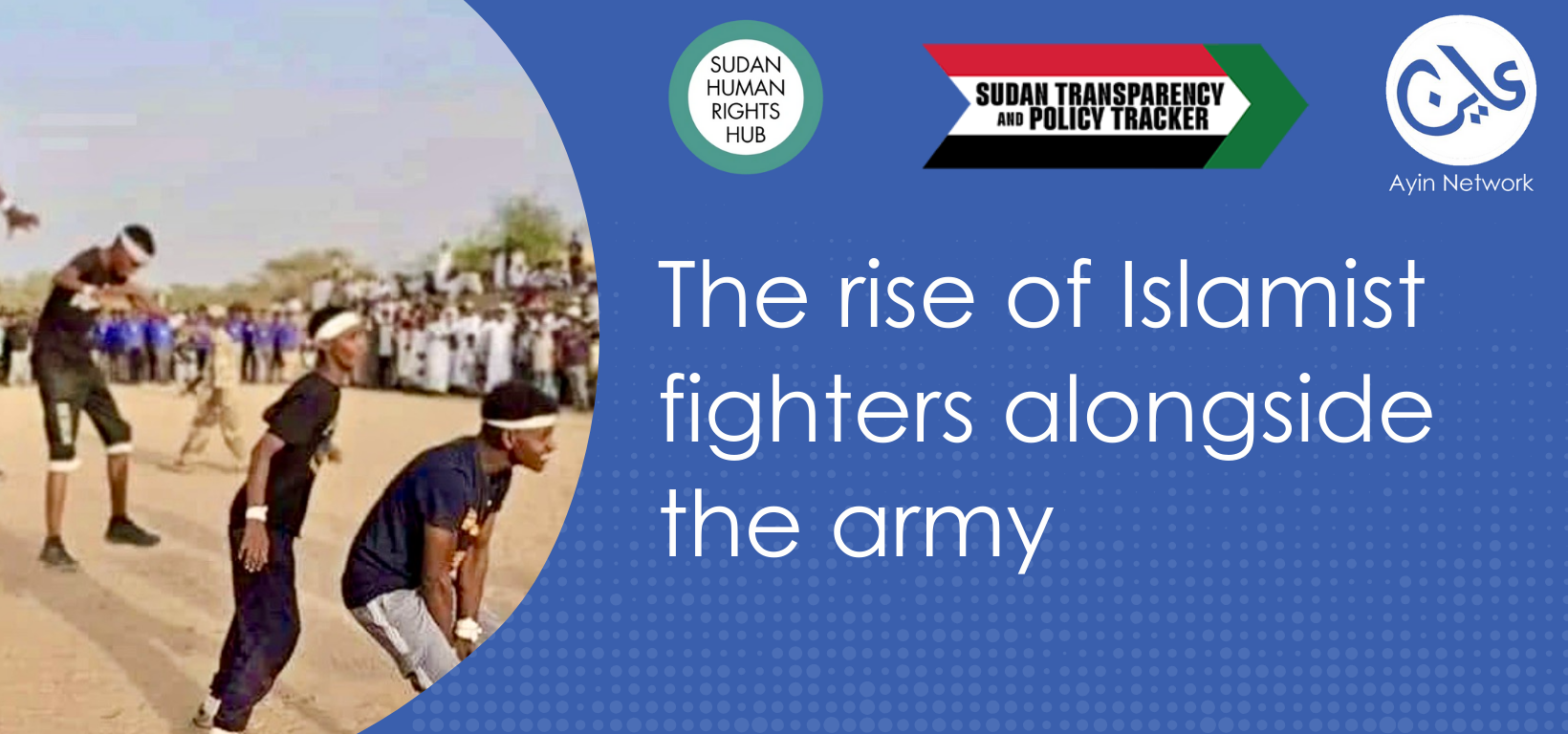
3. The rise of Islamist fighters alongside the army
There are indications that Islamist fighters are playing a more prominent role in spearheading the SAF’s offensives and creating malaise within the SAF senior command. Gen. Shams Al-Din Kabashi, the SAF’s deputy commander, warned in a recent statement that the SAF was losing control over the Popular Resistance Forces (PRF). Sudan’s Islamist hardliners, who are widely believed to be the architects of the war, are taking credit for recent SAF successes and claiming to be the patrons of the Popular Resistance Forces. However, it is widely known that many of the fighters joined for self-defense purposes rather than an ideological commitment to the Islamist cause.
Among the Islamist supporters, the most concerning to SAF command is the Jihadist brigade, Al-Bara’a Ibn Malik which claimed responsibility for the SAF’s recent battle gains using high-tech drones. On March 28, Kabashi instructed SAF divisional commanders to stop issuing arms to volunteers outside army training camps and to stop political groups from accessing the camps with banners, slogans, and battle chants. He also announced that a law was being drafted to regulate the Popular Resistance Forces and guard against their political exploitation. Short of such safeguards, he warned, the Popular Resistance could trigger Sudan’s next crisis. Ironically, he issued the warning at the graduation of 1500 hastily recruited and trained fighters loyal to a Darfur armed group. Days later, Gen. Yasir Al-Atta, assistant commander-in-chief, defended the Popular Resistance Forces and mocked Gen. Kabashi’s warnings as “words blown away by the wind.”
Their role has caused concern for SAF’s senior command, prompting Al-Burhan to address them in a speech to SAF generals in mid-April. According to a report by the independent al-Sudani newspaper, Burhan said the Jihadists’ posts led “many countries” to turn their backs on Sudan. Yet, one of the first things Al-Burhan did when he left the besieged SAF’s general headquarters in Khartoum in August 2023 was to visit Al Bar’aa Ibn Malik’s commander, who was recovering from wounds, sending a strong message of SAF support to the brigade.
The political implications of these tensions are troubling. These actors appear to be engaged in strategic preparations for the post-conflict political landscape. This could herald the formation of a coalition between the Islamist hardliner-led Popular Resistance “movement” and SAF generals. The ongoing relentless campaign of detention and abduction of local leaders of pro-democracy political parties, Resistance Committee activists, and Emergency Response Room volunteers by SAF Military Intelligence and the General Intelligence Services is additional evidence of this agenda.
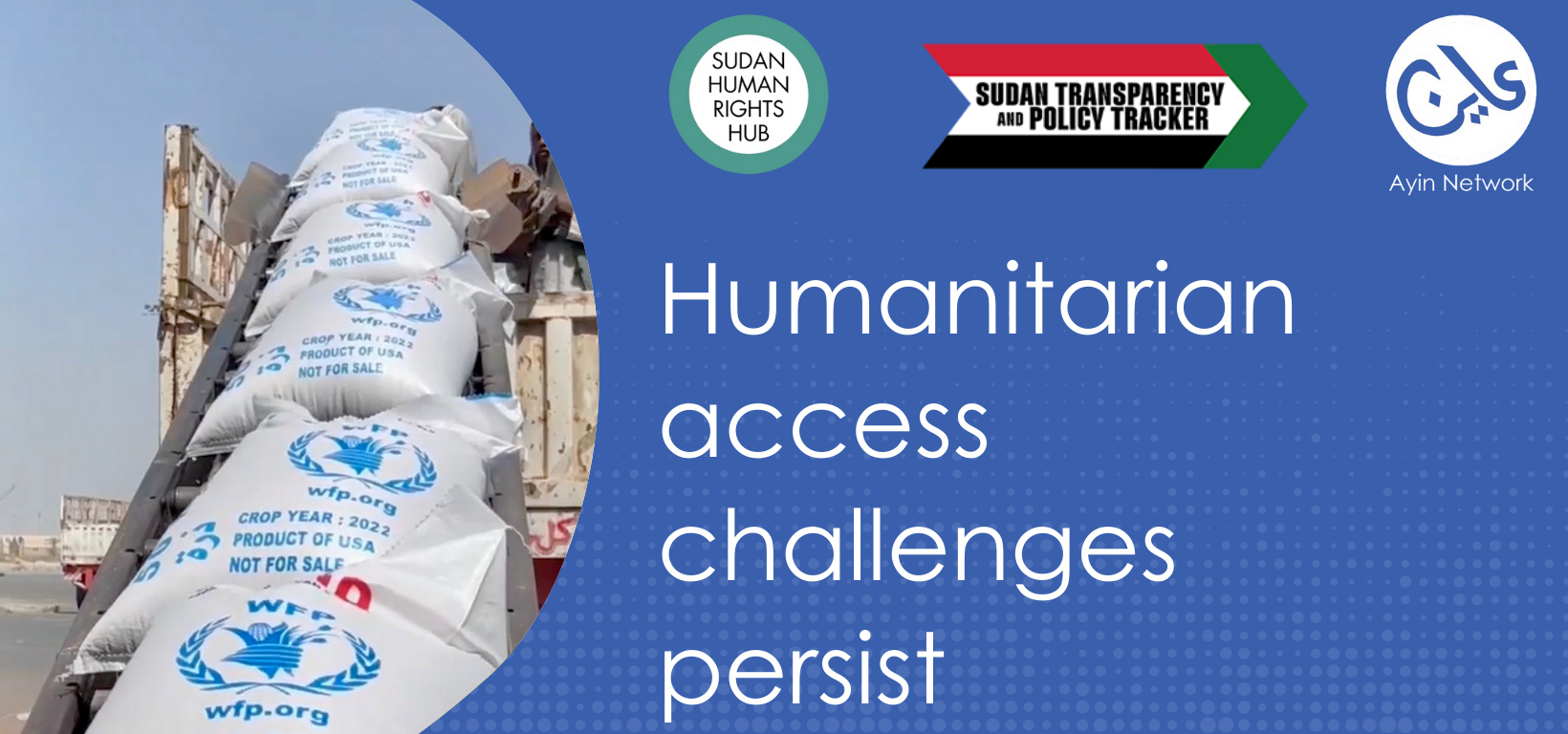
4. Humanitarian access challenges persist
Lack of humanitarian access has remained a persistent issue since the beginning of the April 15th conflict. As detailed in our report last month, the SAF previously blocked cross-border action and then allowed it through a select number of border crossings that were both logistically challenging and fiscally impractical.
At the same time, RSF was deeply suspicious of SAF and JPA armed group control over the authorised routes, fearing that SAF could use these to smuggle weapons. RSF ultimately released a statement refusing to cooperate with SAF’s decision concerning access and seized or delayed several UN convoys in North Darfur in late March.
Immediately prior to the outbreak of El Fasher fighting in April, UN Deputy Resident Humanitarian Coordinator Toby Harward, alongside a UN team, travelled to North Darfur to conduct negotiations on the ground in both El Fasher and Melit. Several informal arrangements, negotiated with state-level officials and local community leaders, allowed the passage of several dozen trucks along the Adre to Geneina route and from Al Fula, West Kordofan, to Darfur. However, with the security situation in El Fasher deteriorating, the status of these negotiations is unclear. With Sudan appearing to be on the verge of famine and increasing mortality rates in Kalma camp in South Darfur indicating that food insecurity is worsening, the urgency to promote a robust response is only increasing.
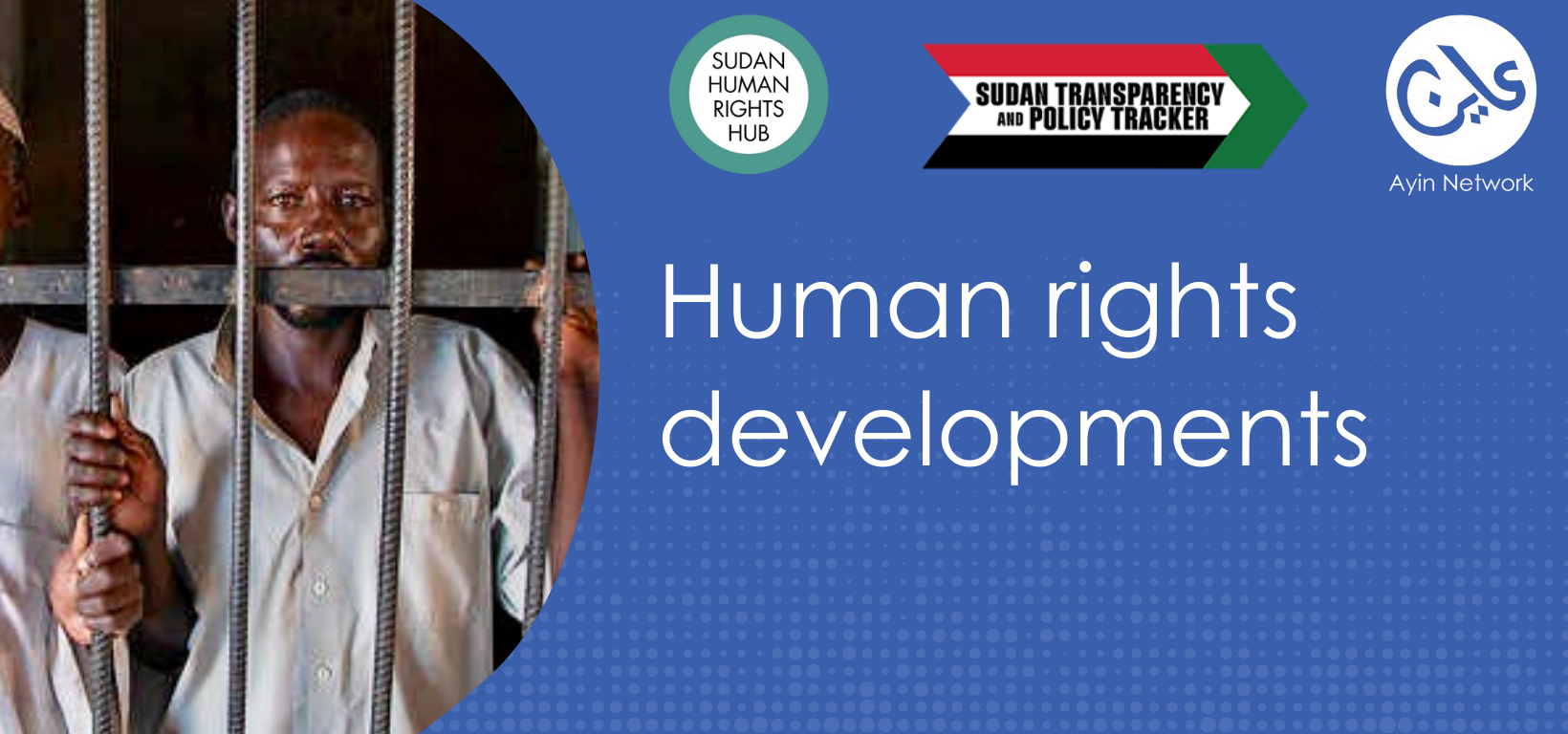
5. Human Rights Developments
Are the warring parties’ human rights bodies effective?
In recent months, both belligerent factions established human rights bodies as public attempts to showcase their respective credibility to the Sudanese public and the international community. While the RSF had operated a Human Rights Department under the leadership of Hasib Yonathan Hamad Koko for several years before the April 15 war, In June last year, Hemedti also announced the creation of “military field courts” and corresponding military police units under the supervision of the third-ranking High Commander, Essam el-Din Salih Fedail.
SAF, in addition to working to restore the ordinary functions of the Attorney General, Judiciary, Ministry of Justice, and Police Services, also established a National Committee for War Crimes and Violations by the Rapid Support Forces in August 2023.
Although Essam el-Din Salih Fedail has a legal background and convened the RSF’s first military trials during its formal establishment in 2013, the RSF has yet to provide evidence that its military field courts have conducted a single trial since the start of the war. There is also little indication that the RSF is upholding basic due process rights in the administration of justice in areas under their control.
In March 2024, Gezira state sources reported that Fedail arrived with several RSF flag officers and a military police unit to address looting and other violations among RSF forces in the state. Local researchers report that the unit detained a group of 20 RSF-aligned militiamen belonging to the Fellata tribe and summarily executed them in Hasahisa. A similar intra-RSF clash occurred around the same time between two RSF units in the village of Abu Gouta, Gezira state, over issues of looting and resulted in the death of a senior RSF commander belonging to the Hamar tribe.
By February 2024, SAF’s National Committee for War Crimes and Violations by the Rapid Support Forces had reportedly received thousands of civilian complaints. SAF has also prosecuted RSF members in its judicial system in at least two instances in recent months. However, the committee has additionally charged 17 members of Taqaddum including former prime minister Abdallah Hamdok, with various crimes. The accusations include provoking war against the state, incitement, conspiracy, undermining the constitutional order, war crimes, crimes against humanity, and genocide.
Since the beginning of the war, there has been an increase in security in SAF-controlled areas of the east. Gen. Yasser al-Atta’s attempts to reinstitute the Bashir-era National Security Law, which gave SAF intelligence services greater authority to arrest people, have most recently highlighted this trend. According to reporting by Ayin, the “cell,” a joint force of intelligence, military intelligence, and investigative police, is now in operation. They patrol areas that are under the control of the SAF, especially those that are considered vulnerable to RSF attacks. Civilians fear that any disagreement with the military authorities may result in them being arrested or even killed. The cell has reportedly committed a range of abuses, including the arrest of young men accused of collaboration with the RSF and raiding homes.
Children are being systematically recruited
In a press release published in March this year, the UN Committee on the Rights of the Child (CRC) warned of systematic violations of children’s rights, especially in the Darfur region, followed by Kordofan and Khartoum.
The two warring parties and their respective allies seek to recruit on a massive scale using civilian mobilisation targeting young boys, according to Sudan’s UNICEF representative. Sources have also shared that the recruitment is now happening all over Sudan and by all parties, including Juba Agreement signatories.
When it comes to RSF recruitment, a large number of videos shared on social media relate testimonies regarding the recruitment of children. Coercive recruitment methods such as intimidation, torture, summary execution, and the withholding of food and medical aid are being widely used.
While RSF recruitment of children started before the war, recruitment by SAF seems to have started soon after April 15, 2023. In the eastern and northern states of the country (Northern State, River Nile, Kassala, Gedaref, Sennar, and West Kordofan), the SAF launched a vast mobilisation campaign in December 2023 to bolster the ranks of the national civil resistance. Al-Baraa Ibn Malik katiba, led by al-Musbah Abu Zaid Talha, plays an important role in recruiting mustanfareen (volunteers), including children.
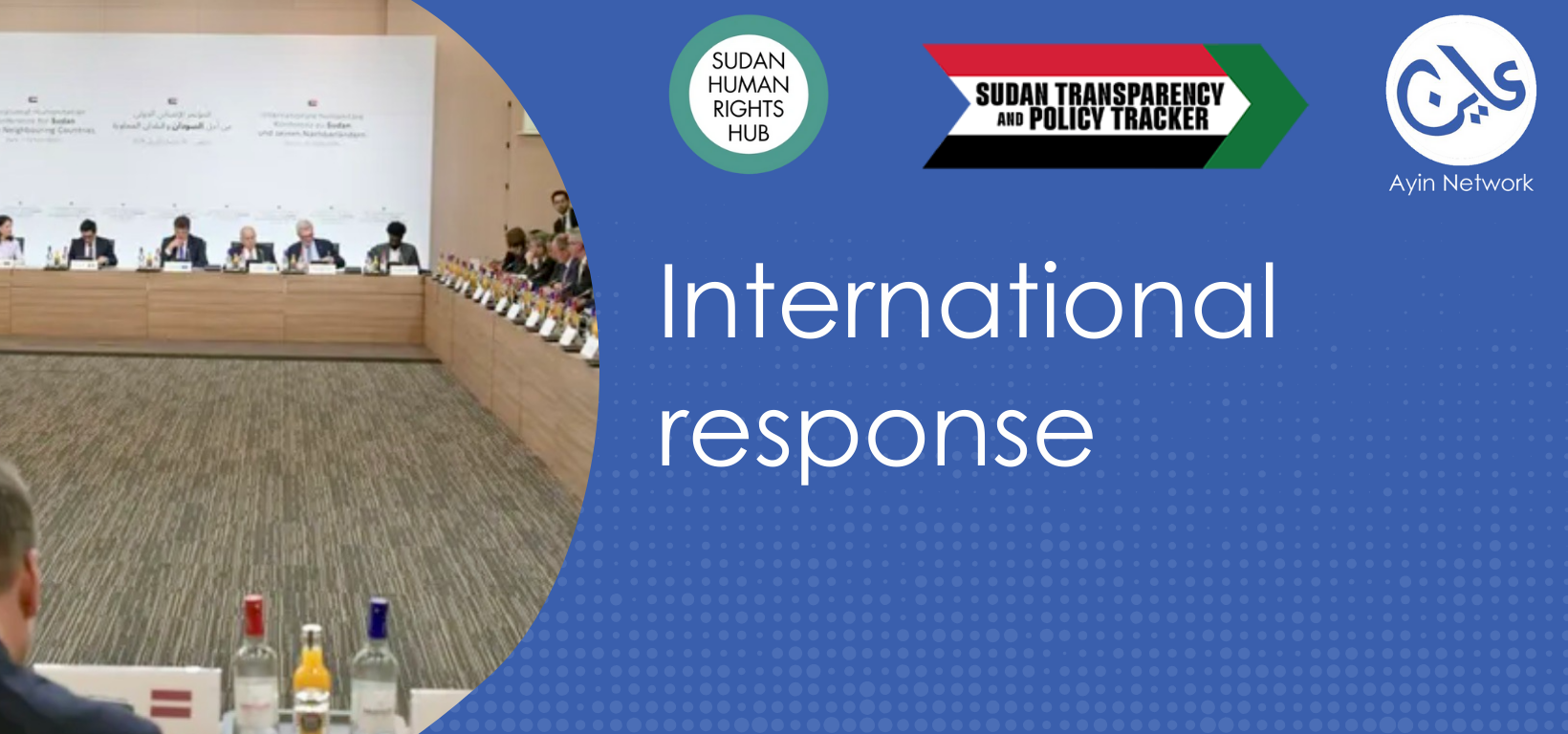
6. International response
The Paris Conference marks the first anniversary of the war and brings new energy to international response
A variety of actors gathered in Paris on the first anniversary of the start of the war to discuss the way forward. Fourteen countries, including France, Germany, the United States, and several organisations such as the African Union, the Arab League, and the European Union, attended.
The conference resulted in about two billion euros in humanitarian pledges, bumping the funding for the humanitarian response in Sudan from 5 to 50%. This included France doubling its aid to €110 million, €244 million from Germany, €138 million from the United States and €355 million from the European Union. The participants also called on the belligerents to respect international law and not hinder the delivery of aid.
International NGO representatives, however, pointed out that more needs to be done. While the new pledges are welcome, experts are concerned that they will not be enough to avoid famine in Sudan. It is unclear to whom and how the funds will be disbursed, and this will, of course, impact their effectiveness. There is also a need to go beyond funding to address access issues at a policy level. Right now, much of Darfur and Khartoum are inaccessible. Cross-border access through Adré, Chad, is vital for reaching RSF-controlled areas in West, South, and East Darfur. While there is no physical barrier to entry there, UN agencies are fearful that doing so without SAF permission could lead to retaliation against their staff or programming in eastern Sudan. Greater advocacy is needed to both pressure the SAF to accept access and to find creative solutions.
Part of what can be supported as innovative solutions is the work of the local humanitarian responders in the Emergency Response Rooms. NGOs at the conference highlighted the need to recognise them as humanitarian actors entitled to protections as such.
On the political side, the outcomes of the session were more ambiguous. Neither party to the conflict was represented at the conference, and the initial French ambition to “make sense of mediation efforts” appears only to have been reflected in the joint declaration call “on all regional and international actors to fully support a consolidated peace initiative for Sudan.” They also called for an immediate ceasefire and “urged all foreign actors to cease providing armed or material support to the parties to the conflict and to refrain from any action that would exacerbate tensions and fuel the conflict.”
In conjunction with the pledging ministerial meeting, Paris hosted a conference of civil forces at the Arab World Institute. This was the first time a civil force broader than Taqaddum had come together since the start of the war. The meeting brought together some 50 political actors from multiple schools of thought, many of whom had not met since the outbreak of war. Attendees included former Prime Minister Abdallah Hamdok, leader of Taqaddum, Miryam al Sadiq al Mahdi of the National Umma Party, the Sultan of the Masalit community, leaders of the FFC-Democratic Block rival to Taqaddum, independent Islamist writers and thought leaders, and the Justice and Equality Movement. Unfortunately, only one participant from the local Emergency Response Rooms was present in the meeting, even though the ERRs are doing heroic work on the ground in Sudan.
By bringing together such a broad spectrum of Sudanese political actors, the Paris Conference achieved a promising breakthrough in the Sudanese crisis by generating momentum for coalition building among civilians seeking an end to the war and the restoration of a sound transition to democracy. Concerned about this outcome of the conference, Islamist campaigners launched virulent attacks on social media, depicting the Paris Conference as a world conspiracy engineered by Taqaddum to weaken the SAF’s war effort and demanded the immediate firing of Foreign Minister Ali El-Sadiq for failing to object to the convening of the meeting. The minister’s firing on April 17 is primarily a response to the campaign. Although it was heartening to see some momentum coming out of the discussions in Paris, the key question now is how to maintain momentum to ensure that responses become more robust rather than evaporating in the coming months.
A new IGAD Envoy
IGAD has appointed a new envoy for Sudan, South Sudanese lawyer Lawrence Korbandy. The advocate is a former chair of South Sudan’s Human Rights Commission and adviser to President Salva Kiir. He has been tasked with providing good offices, but it is unclear how his role will fit alongside that of other special envoys and what impact he will have.
New sanctions
On the anniversary of the conflict, the UK announced a new set of sanctions on companies it believes are supporting the warring parties, including Al-Khaleej Bank, a bank working with the RSF, and Red Rock Mining, a mining company associated with the army. Additionally, Canada announced new sanctions against organisations like Al Junaid For Multi Activities Co. that the US and UK had already imposed in relation to the conflict.
Peace talks are to restart soon
Peace talks in Jeddah are expected to restart soon. The US and Saudi facilitators have delayed sending the official invitations to the SAF and the RSF while covertly talking to them to ensure the highest possible representation from both in Jeddah. While this tactic has triggered delays, the objective is to secure the implementation of commitments their representatives sign on to at the talks.
More from our partner organisations:
Ayin Network
Follow Ayin: Youtube Facebook Twitter
- One year anniversary of war, April 2024
- Sudan’s food war and impeding famine in Darfur, April 2024
Sudan Human Rights Hub
- Sudan’s health care system nears collapse: Part 2, March 2024
- Sudan Attacks on Healthcare Since April 15, 2023, March 2024
Sudan Transparency and Policy Tracker
Sign up to the Sudan Transparency and Policy Tracker newsletter here
- Blue Nile, its conflict dynamics, and the potential implications for the wider war in Sudan April 2024
- The implications of the current war on the Chad-Sudan relationship April 2024



